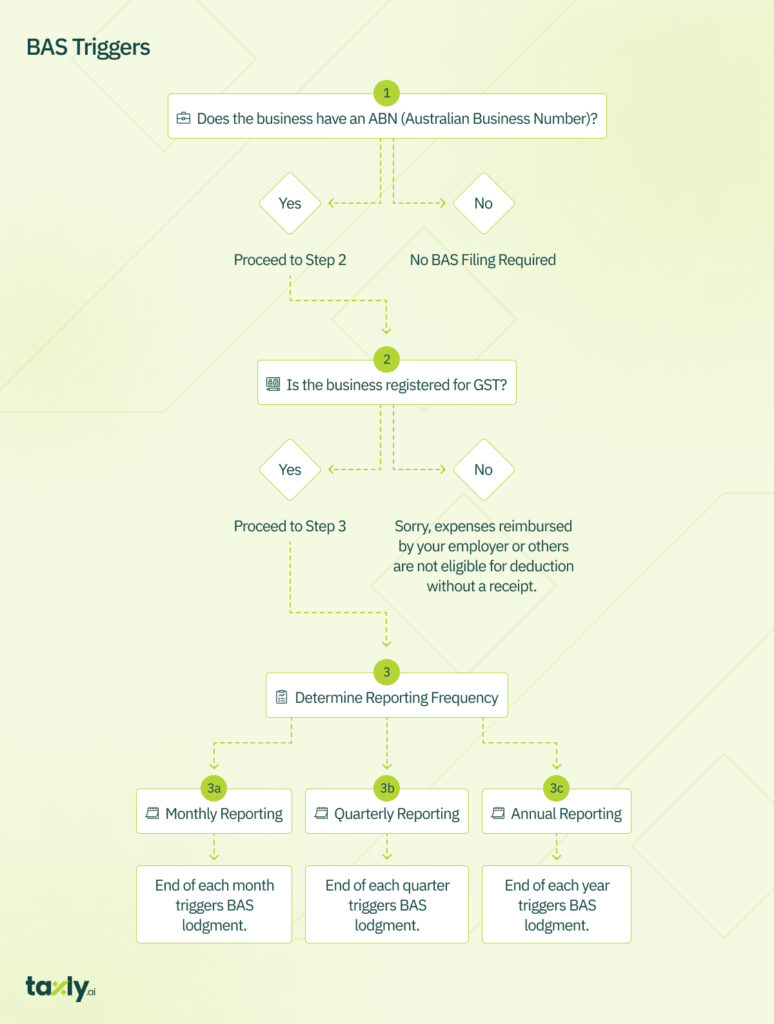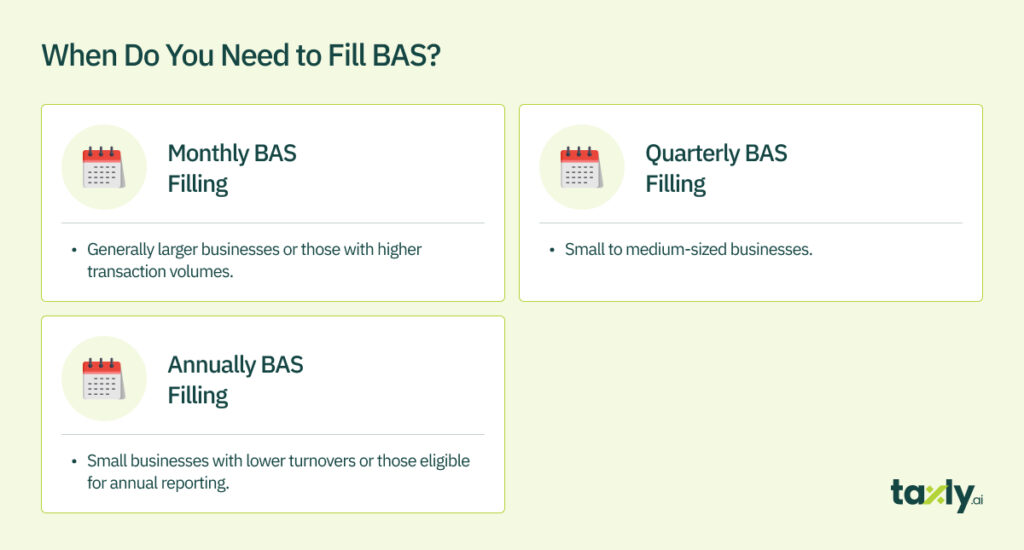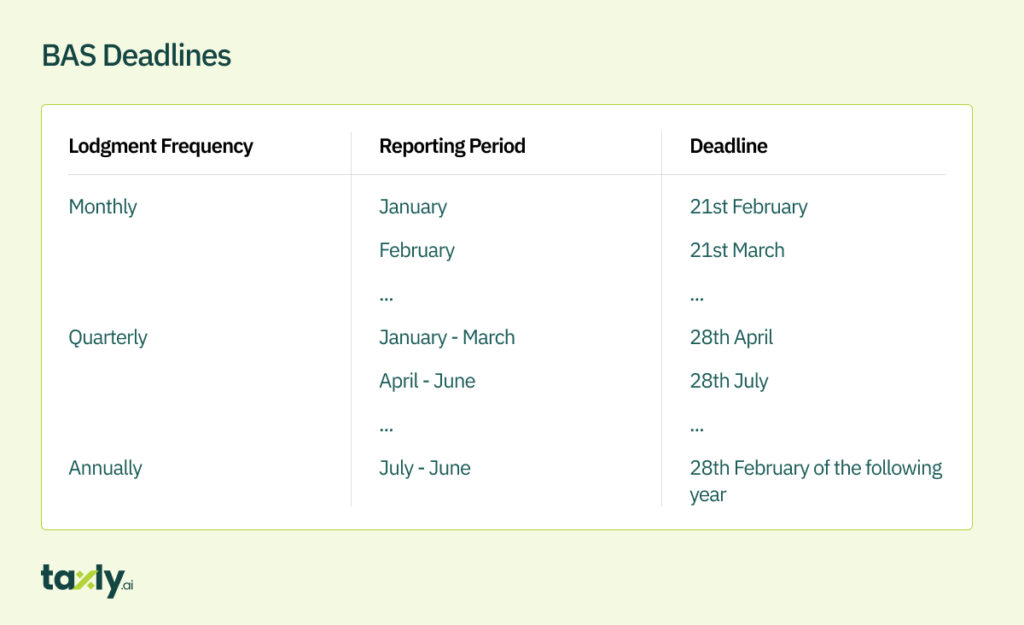I remember when I first started my freelance writing gig. The BAS seemed daunting! But I learned that staying organized, keeping receipts handy, and tracking income and expenses regularly made BAS time a breeze.
The Business Activity Statement (BAS) in Australia is a crucial form that businesses submit to the Australian Taxation Office (ATO). It’s like a financial report card summarizing various tax obligations.
BAS covers significant elements like Goods and Services Tax (GST), Pay-As-You-Go (PAYG) withholding, and specific taxes such as Wine Equalization Tax (WET) and Fuel Tax Credits (FTC).
Think of BAS as your business’s tax snapshot. For instance, imagine running a bakery. When you sell cakes or pastries, the GST you collect from customers goes into your BAS. However, if you buy ingredients (like flour or sugar) and the GST applies, that becomes a credit in your BAS.

What are Key Entries in BAS?
The BAS form in Australia encompasses several key elements or fields:
- Goods and Services Tax (GST):
This includes the GST amounts collected on sales and the GST credits for purchases. Essentially, it’s about what you owe the ATO from sales and what the ATO owes you from your business expenses.
- Pay-As-You-Go (PAYG) Tax Withheld:
This section involves the tax that businesses withhold from their employees’ wages or payments made to other businesses that don’t quote an Australian Business Number (ABN).
- PAYG Installment:
Businesses that make a profit might need to pay income tax in installments throughout the year. This part of the BAS deals with those payments.
- Fringe Benefit Tax (FBT):
For businesses providing non-wage employee benefits (like a company car), FBT comes into play. It’s a tax on these perks provided to employees.
Suggested Read: How Fringe Benefit Tax Works – All You Need to Know
- Other Specific Taxes:
These can include additional taxes depending on the business activities. For example, Wine Equalisation Tax (WET) for businesses involved in selling wine and Fuel Tax Credits (FTC) for those using fuel for eligible business activities.
Which Businesses Need to Fill Out BAS?
In Australia, various businesses are required to lodge a Business Activity Statement (BAS) if they meet specific criteria. Here are the primary categories and examples:
GST-Registered Businesses:
Most businesses with an annual turnover of $75,000 or more must register for Goods and Services Tax (GST). These include:
- Retailers: Shops selling goods to customers.
- Service Providers: Consultants, freelancers, plumbers, electricians.
- Online Sellers: E-commerce stores selling products.
- Hospitality: Restaurants, cafes, hotels.
Businesses Providing Taxable Supplies:
Even if a business’s turnover is under $75,000, they might still need to register for GST if they provide taxable supplies. These could include:
- Import/Export Businesses: Dealing with international trade.
- Manufacturers: Producing goods for sale.
- Wholesalers: Selling goods in bulk to retailers.
Specific Industries Subject to Other Taxes:
Certain industries have additional taxes that require BAS filing, such as:
- Wineries: Subject to Wine Equalisation Tax (WET).
- Transport Companies: Eligible for Fuel Tax Credits (FTC).
- Employers: With PAYG withholding obligations.
Suggested Read: What Does Tax Withheld Mean in Australia?
Which Businesses Do Not Need to Fill BAS?
Not all businesses need to fill out all these sections.
Businesses Below the GST Threshold:
If a business has an annual turnover below $75,000 and doesn’t meet any other GST registration criteria, it doesn’t need to register for GST or submit a BAS. Examples include:
- Small hobbyist ventures.
- Micro-businesses with limited turnover.
Specific GST-Free Businesses:
Some businesses might be exempt from GST due to the nature of their products or services. For instance:
- Healthcare Services: Many medical services are GST-free.
- Basic Food Items: Most basic food items are GST-free.
Non-Business Entities:
Individuals or entities not operating as businesses generally don’t need to submit a BAS. This includes:
- Personal income earners without business activities.
- Non-profit organizations not engaged in business activities.
Businesses Exempt from GST for Other Reasons:
Certain business types might be exempt from GST due to their operations or specific regulations. For example:
- Religious institutions.
- Some government entities.
The fields you complete depend on your specific business registrations and whether you’re doing a monthly or quarterly BAS. Each element represents a different aspect of your business’s financial activities, and accurately reporting them ensures compliance with tax regulations.

The BAS (Business Activity Statement) filling is triggered by the tax cycle and is typically dependent on the reporting period and the frequency of lodgment chosen by the business.
For monthly lodgment:
- The BAS filling is usually triggered by the end of each month. For example, if you’re reporting for January, the BAS for that month would typically be due by the 21st of February.
For quarterly lodgment:
- The BAS filling is triggered by the end of each quarter, which are typically March, June, September, and December. For instance, the BAS for the March quarter would typically be due by the 28th of April.
For annual lodgment:
- Some businesses might be eligible for annual BAS lodgment. In this case, the BAS is triggered by the end of the financial year in Australia, which is June 30th. The annual BAS is usually due by the 28th of February following the end of the financial year.
The triggering of BAS filling is directly linked to the end of these reporting periods, where businesses compile their financial information for the respective period and submit it to the Australian Taxation Office (ATO) within the specified timeframe.
How Frequently Do You Fill BAS?
Now, the frequency of lodging this report depends on your business size—ranging from monthly to annually. Smaller businesses might file it less often, while larger ones tackle it more frequently. For example, a small online craft store might file quarterly, while a big retail chain likely reports monthly.
Where can you Access BAS Form?
The Business Activity Statement (BAS) form in Australia is available from several sources:
- Australian Taxation Office (ATO) Website: The ATO provides access to BAS forms on their website. You can download and print the form from the ATO’s online services or forms section.
- Registered Tax Agents or BAS Agents: Tax professionals and registered agents often have access to BAS forms and can provide them to businesses they represent.
- ATO Offices or Service Centers: Physical ATO offices or service centers might have printed BAS forms available for pick-up.
- AI Powered Tax App: Use Taxly.Ai to get all the help you need for filling your BAS Tax forms.
Regardless of the source, ensure you are using the most recent version of the BAS form to accurately report your business activities and fulfill your tax obligations.
What Happens if you Miss BAS Deadlines?
One crucial thing to note: missing deadlines can lead to penalties! For monthly BAS, the due date typically falls on the 21st of the following month, while quarterly due dates are usually on the 28th.

What are BAS Credits?
BAS credits refer to the amount of Goods and Services Tax (GST) credit a business can claim on its Business Activity Statement (BAS). These credits represent the GST paid on business-related purchases, expenses, or acquisitions.
When a business buys goods or services for its operations and the supplier charges GST, the business can claim this GST amount as a credit. BAS credits effectively reduce the amount of GST owed to the Australian Taxation Office (ATO). The credits are deducted from the GST the business collects on its sales.
For instance, if a business collects $5,000 in GST from its sales in a reporting period but has paid $3,000 in GST on various business-related purchases during the same period, it can claim a BAS credit of $3,000. This means the business will remit only $2,000 ($5,000 – $3,000) to the ATO as its net GST obligation for that period.
BAS credits are an essential aspect of managing a business’s cash flow and tax obligations, as they allow businesses to offset the GST paid against the GST collected, potentially resulting in a refund if the credits exceed the GST owed.
How do BAS Credits Work?
Bas credits work as a mechanism for businesses to offset the GST they’ve paid on their purchases against the GST they’ve collected on their sales. Here’s a breakdown of how it works:
GST Paid on Purchases: When a business buys goods or services for its operations, suppliers often include GST in the price. This GST paid on these purchases is a cost to the business.
Claiming GST Credits: Businesses can claim GST credits on their Business Activity Statement (BAS) for the GST they’ve paid on these purchases. This process involves reporting the GST paid on eligible business-related expenses.
Offsetting GST Collected: On the same BAS, businesses report the GST collected from their sales. This is the GST charged to customers on the goods or services sold.
Calculating Net GST: The business then calculates the net GST amount owed to the Australian Taxation Office (ATO) by subtracting the GST credits (purchases) from the GST collected (sales). If the credits exceed the collected GST, the business might receive a refund. Conversely, if the GST collected is higher, the business owes the difference to the ATO.
For example:
- Let’s say a business collects $10,000 in GST from sales in a reporting period.
- During the same period, it pays $7,000 in GST on business-related expenses.
- The business can claim GST credits of $7,000, reducing the GST owed to $3,000 ($10,000 – $7,000).
- If this $3,000 is less than what the business already remitted, it needs to pay the difference. If it’s more, the excess might be refunded.
In essence, BAS credits help businesses manage their cash flow by allowing them to reclaim GST paid on purchases, effectively reducing the overall GST liability.
Benefits of BAS Credits for Businesses
BAS credits are like a helpful cash cushion for businesses in a few key situations:
Cash Flow Ease:
They’re great for balancing the books. When a business claims BAS credits for the GST they’ve paid on things like purchases or expenses, it’s like getting a refund. This reduces the amount of GST they owe at tax time, easing up on immediate cash needs.
For example: Suppose a small bakery claiming BAS credits on the flour, eggs, and sugar they purchased. Let’s say they paid $2,000 in GST on these supplies. When they report this on their BAS, that $2,000 becomes a credit, reducing the GST they owe on their sales. This helps the bakery keep more cash in hand for day-to-day operations or to invest in new recipes or equipment.
Tax Breaks:
BAS credits also work like a magic trick to cut down on tax bills. By claiming these credits, businesses can lower how much they owe in taxes, giving them a break on their overall tax payments.
For example: Consider a consulting firm that spent $10,000 on new computers and software, paying $1,000 in GST. By claiming this $1,000 as a BAS credit, they lower their taxable income, potentially saving hundreds of dollars in income tax.
Boosting Profits:
Imagine getting money back on the things you spend on for your business—those credits can boost profits by reducing the overall costs of doing business.
For example: An online retailer selling fashion accessories imports goods and pays $5,000 in GST on their purchases. When they claim these BAS credits, it directly cuts into their cost, potentially improving profit margins on each sale.
Potential Refunds:
Sometimes, the credits a business gets from GST claims can be more than what they’ve collected. That means they could get a refund, which can be a sweet deal for their finances.
For example: A small graphic design studio invests heavily in new design software, paying $3,000 in GST. However, due to a slower quarter in sales, they only collect $2,000 in GST from their clients. They can claim the $3,000 as credits and might receive a $1,000 refund from the ATO, providing a helpful financial boost.
Fuel for Growth:
Having these credits on hand can free up cash that businesses can then use to grow—whether that’s expanding, buying new gear, or hiring more help.
For example: Imagine a landscaping company claiming BAS credits on fuel purchases for their machinery, totaling $4,000 in GST. Those credits could be the extra cash needed to buy new tools, hire additional workers, or expand their service offerings.
In a nutshell, BAS credits are a nifty tool that helps businesses manage their money better, cut down on taxes, and even get a little extra boost for future plans.
The Bottomline
BAS is a tool to manage your business’s financial health. If you’re unsure, consulting with a BAS agent or using the ATO’s online services can be a game-changer. They’ve got tools and experts to simplify this tax jigsaw puzzle for you.
So, whether you’re a small café owner or a budding entrepreneur, mastering BAS means staying on top of your tax game and ensuring your business runs smoothly without any tax-related hiccups!
Discover More Topics


Comments are closed